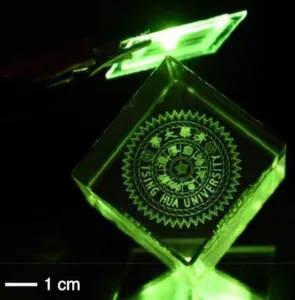A team of researchers led by Tien-Lin Wu, a postdoc in the Department of Chemistry at the National Tsing Hua University (Hsinchu, Taiwan) has developed a new Thermally Activated Delayed Fluorescence (TADF) Organic Light Emitting Diode (OLED) emitter material. The development work includes both theoretical and experimental investigations.
TADF has been called “a relatively new class of OLED emitter materials that promise efficient and long-lifetime performance without any heavy metals.” Despite their promise, TADF OLED materials are not without problems. So far, TADF OLED materials have suffered from efficiency roll-off at high luminance. This is the issue that was the subject of investigations conducted by the team.
A recent article reporting the results of the team’s investigations is entitled “Diboron compound-based organic light-emitting diodes with high efficiency and reduced efficiency roll-off.” It was published in Nature Photonics (2018). A copy of the article is available for purchase and can be found here. The article contains a great deal of detailed technical information on the design and structure of the TADF materials, the mechanism by which they emit light, the means used to measure the properties of a device made from the material and the results of these measurements. Here is a top level summary of the more important results.
The team designed and synthesized two diboron-based molecules called CzDBA and tBuCzDBA. Both demonstrated excellent TADF properties. “These donor-acceptor-donor type, rod-like compounds concurrently generate TADF with a photoluminescence quantum yield of ~100% and an 84% horizontal dipole ratio in the thin film.”
The researchers fabricated a TADF OLED test device that emitted green light and that was based on CzDBA. It achieved a high external quantum efficiency of about 37.8%, a current efficiency of 139.6 ± 2.8 cd/A and a power efficiency of 121.6 ± 3.1 lm/W. The efficiency roll-off was only 0.3% at 1,000 cd/m2. The researchers comment that “this new material is the world’s most efficient TADF emitter at high brightness.”
The test device has a peak emission wavelength of 528 nm and CIE color coordinates of (0.31, 0.61). With these specifications, the material is represented as a good candidate for use in color display applications.
The team also reports on measurements made of the lifetime of a test device fabricated with the new material.
A photograph of a test device made with the CzDBA material appears in the figure below.
A test device made with the CzDBA material.
In their just published article, the team proposes several possible explanations as to why the roll-off at high luminance has been reduced in the new material.
The team’s article concludes by stating the belief that their recent work can form the basis of the future molecular design of highly efficient TADF-based OLEDs. -Arthur Berman
National Tsing-Hua University, Tien-Lin Wu, [email protected]

